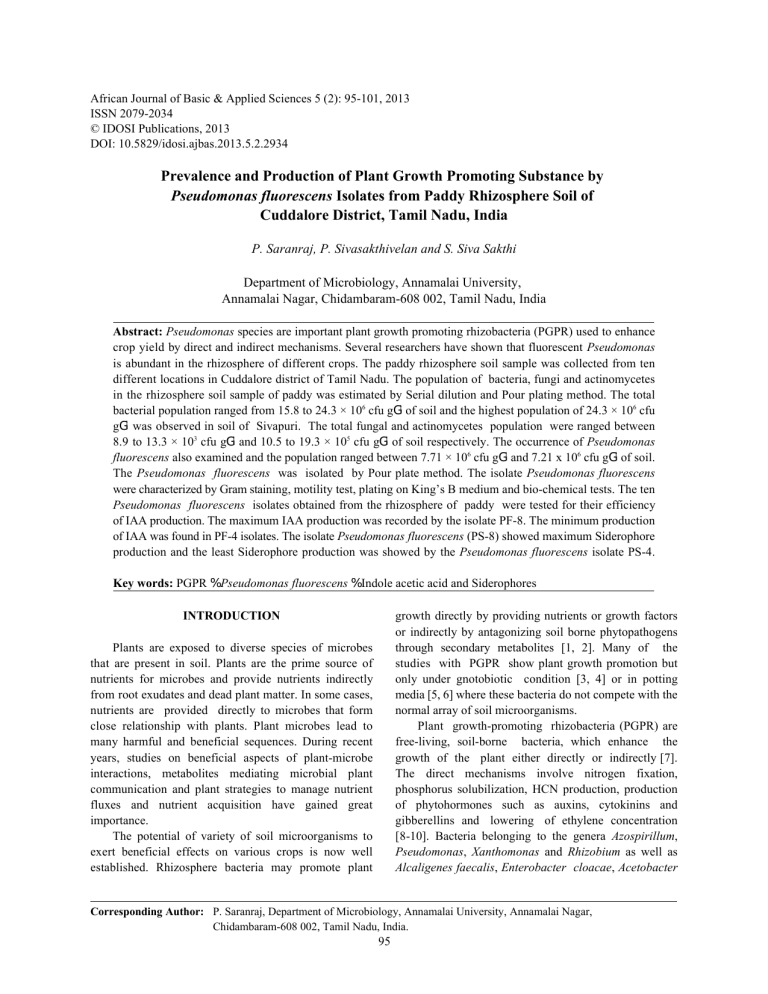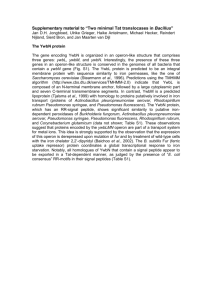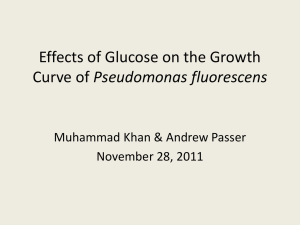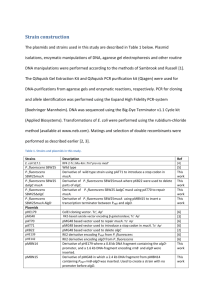Saranraj37
advertisement

African Journal of Basic & Applied Sciences 5 (2): 95-101, 2013 ISSN 2079-2034 © IDOSI Publications, 2013 DOI: 10.5829/idosi.ajbas.2013.5.2.2934 Prevalence and Production of Plant Growth Promoting Substance by Pseudomonas fluorescens Isolates from Paddy Rhizosphere Soil of Cuddalore District, Tamil Nadu, India P. Saranraj, P. Sivasakthivelan and S. Siva Sakthi Department of Microbiology, Annamalai University, Annamalai Nagar, Chidambaram-608 002, Tamil Nadu, India Abstract: Pseudomonas species are important plant growth promoting rhizobacteria (PGPR) used to enhance crop yield by direct and indirect mechanisms. Several researchers have shown that fluorescent Pseudomonas is abundant in the rhizosphere of different crops. The paddy rhizosphere soil sample was collected from ten different locations in Cuddalore district of Tamil Nadu. The population of bacteria, fungi and actinomycetes in the rhizosphere soil sample of paddy was estimated by Serial dilution and Pour plating method. The total bacterial population ranged from 15.8 to 24.3 × 106 cfu gG1 of soil and the highest population of 24.3 × 106 cfu gG1 was observed in soil of Sivapuri. The total fungal and actinomycetes population were ranged between 8.9 to 13.3 × 103 cfu gG1 and 10.5 to 19.3 × 105 cfu gG1 of soil respectively. The occurrence of Pseudomonas fluorescens also examined and the population ranged between 7.71 × 106 cfu gG1 and 7.21 x 106 cfu gG1 of soil. The Pseudomonas fluorescens was isolated by Pour plate method. The isolate Pseudomonas fluorescens were characterized by Gram staining, motility test, plating on King’s B medium and bio-chemical tests. The ten Pseudomonas fluorescens isolates obtained from the rhizosphere of paddy were tested for their efficiency of IAA production. The maximum IAA production was recorded by the isolate PF-8. The minimum production of IAA was found in PF-4 isolates. The isolate Pseudomonas fluorescens (PS-8) showed maximum Siderophore production and the least Siderophore production was showed by the Pseudomonas fluorescens isolate PS-4. Key words: PGPR % Pseudomonas fluorescens % Indole acetic acid and Siderophores INTRODUCTION growth directly by providing nutrients or growth factors or indirectly by antagonizing soil borne phytopathogens through secondary metabolites [1, 2]. Many of the studies with PGPR show plant growth promotion but only under gnotobiotic condition [3, 4] or in potting media [5, 6] where these bacteria do not compete with the normal array of soil microorganisms. Plant growth-promoting rhizobacteria (PGPR) are free-living, soil-borne bacteria, which enhance the growth of the plant either directly or indirectly [7]. The direct mechanisms involve nitrogen fixation, phosphorus solubilization, HCN production, production of phytohormones such as auxins, cytokinins and gibberellins and lowering of ethylene concentration [8-10]. Bacteria belonging to the genera Azospirillum, Pseudomonas, Xanthomonas and Rhizobium as well as Alcaligenes faecalis, Enterobacter cloacae, Acetobacter Plants are exposed to diverse species of microbes that are present in soil. Plants are the prime source of nutrients for microbes and provide nutrients indirectly from root exudates and dead plant matter. In some cases, nutrients are provided directly to microbes that form close relationship with plants. Plant microbes lead to many harmful and beneficial sequences. During recent years, studies on beneficial aspects of plant-microbe interactions, metabolites mediating microbial plant communication and plant strategies to manage nutrient fluxes and nutrient acquisition have gained great importance. The potential of variety of soil microorganisms to exert beneficial effects on various crops is now well established. Rhizosphere bacteria may promote plant Corresponding Author: P. Saranraj, Department of Microbiology, Annamalai University, Annamalai Nagar, Chidambaram-608 002, Tamil Nadu, India. 95 African J. Basic & Appl. Sci., 5 (2): 95-101, 2013 diazotrophicus and Bradyrhizobium japonicum have been shown to produce auxins which help in stimulating plant growth [11]. The genus Pseudomonas is one of the most diverse Gram negative bacterial genera, isolated from sources ranging from plants to soils and water of this genus are straight or slightly curved rods, motile by means of polar flagella. Pseudomonas is characterized by their ability to grow in simple media at the expense of a great variety of simple organic compounds, without needing organic growth factors. King’s B media is an optimal for most species of Pseudomonas isolation. King [12] developed the first selective media (King’s A and King’s B) for the isolation of fluorescent Pseudomonas. In recent years there has been much success in obtaining biological control of plant pathogens using bacterization techniques [13]. Bacteria used, as inoculants are mostly Pseudomonas fluorescens types obtained from soils and plant surfaces. Some of these bacteria produce metabolites, which chelate the environmental iron thus making it unavailable to pathogens [14]. To date a number of these diseases suppressive antibiotic compounds have been characterized chemically and include N-containing heterocycles such as phenazines, pyrrole type antibiotics, pyo-compounds13 and indole derivatives [15]. Isolation and Enumeration of Pseudomonas Fluorescens Population: The paddy rhizosphere soil samples collected from ten paddy field of a particular location, were pooled and one ml of paddy rhizosphere soil sample was transferred to 100ml of sterile distilled water in a 250ml Erlenmeyer flask and incubated on a rotator shaker (100rpm) for 30 minutes at an ambient temperature. The well mixed suspension was then diluted appropriately up to 10G6 dilution. One ml of suspension from 10G4 and 10G5 dilution was aseptically transferred to sterile petriplates and 10-20ml of selective King’s B medium was added and incubated at 37°C for 24 hours. Three replications were maintained for each dilution. The colonies were counted by using Colony counter. The total number of colonies in the original samples was expressed as cfu gG1. All the ten Pseudomonas fluorescens isolates were purified by Streak plate method using King’s B medium frequently. Designation of Pseudomonas Fluorescens Isolates: The Pseudomonas fluorescens isolates, obtained from the rhizosphere of paddy grown at ten different location of Cuddalore District and were designated as PF and numbered randomly. Characterization of Pseudomonas Fluorescens Isolates: Identification of the Pseudomonas fluorescens were carried out by the routine bacteriological methods i.e., MATERIALS AND METHODS Details of the Locations: The survey was conducted at ten locations in Cuddalore district of Tamil Nadu comprising Annamalai Nagar, Bhuvanagiri, Kurinjipadi, Vadalur, Neyveli, Keelamoongiladi, Vayalore, Sivayam, Kannangudi and Mangalam. C C Collection of Paddy Rhizosphere from Different Locations: In each and every location of the survey area a field which has been under long behind mono culture practice was selected. The locations of rhizosphere samples were made at different location of the paddy field. The collected soil samples were brought to the laboratory for further analysis. Quantitative Estimation of Indole Acetic Acid (IAA) in Pseudomonas Fluorescens: Indole acetic acid production by Pseudomonas fluorescens isolates was estimated in the present study. 100 ml of King’s B broth containing 0.005 M L-tryptophan was sterilized in 250 ml conical flash. Each isolate of Pseudomonas fluorescens was grown over night in King’s B broth was inoculated to the above each culture medium and incubated at 37°C for 7 to 12 days in dark. Duplicate flasks were maintained for each isolates. The cultures were centrifuged at 6000 rpm at refrigerated centrifuge at 4°C and the supernatant was collected in a conical flask and used for estimation of Indole Acetic Acid. 25 ml of supernatant was taken in 100ml conical flask and pH was adjusted to 2.8 C C Microbiological Analysis of Soil Samples: The population of bacteria, fungi and actinomycetes in the rhizosphere soil sample of paddy were estimated by Serial dilution and Pour plating method, using appropriate dilutions and the following media. The colonies were counted and expressed as cfu gG1. 96 By the colony morphology Preliminary tests like Gram staining, Capsule staining, Endospore staining, Motility, Catalase and Oxidase. Plating on selective media. By performing biochemical tests. African J. Basic & Appl. Sci., 5 (2): 95-101, 2013 using/NH4Cl. Equal volume of diethyl ether was added to it and incubated in dark hours. Diethyl ether extraction of Indole Acetic Acid was done in a separating funnel. The organic phase was discarded and the solvent phase was pooled and evaporated to dry. To the dried material, two ml of methanol was added and the Indole Acetic Acid present in the methanol extract was determined using the method explained by Gorden and Paleg [16]. To 0.5ml of Methanol extract, 1.5ml of distilled H2O and 4.0 ml of Salper’s reagent (1.0 ml of 0.5 FeCl3 in 50 ml of 35% are 25% Perchloric acid) was added and incubated in dark for one hour and red at 535 nm in a Spectrophotometer. From a standard curve prepared with known concentration of Indole Acetic Acid, the quantity of Indole Acetic Acid in the culture filtrate was determined and expressed as mg/100 ml of the medium. 0.1 M potassium ferricyanide was added) was prepared. Five ml of the assay solution was added with five ml of Hathway reagent and absorbance was determined at 560 nm with sodium salicylate as standard for the estimation of salicylate type of siderophore. To measure the catechol type siderophore, five ml of the assay solution was added with five ml Hathway reagent and absorbance was determined at 700 nm with 2, 3 dihydroxy benzoic acid (DHBA) as a standard. One µ mole of 2,3-DHBA gave an absorbance of 0.75. From the absorbance value of the sample, the quantum of siderophore produced was calculated and expressed as µg mlG1 of culture filtrate. RESULTS AND DISCUSSION The survey was conducted at ten locations in Cuddalore district of Tamil Nadu comprising Annamalai Nagar, Bhuvanagiri, Kurinjipadi, Vadalur, Neyveli, Keelamoongiladi, Vayalore, Sivayam, Kannangudi and Mangalam. In each and every location of the survey area a field which has been under long behind mono culture practice was selected. The locations of rhizosphere samples were made at different location of the paddy field. The collected soil samples were brought to the laboratory for further analysis. The collected soil samples were analyzed for the total population of Bacteria, Fungi and Actinomycetes and the results are presented in Table 1. The results revealed that the total bacterial population ranged from 15.8 to 24.3 × 106 cfu gG1 of soil and the highest population of 24.3 × 106 cfu gG1 was observed in soil of Sivapuri. The total fungal and actinomycetes population were ranged between 8.9 to 13.3 × 103 cfu gG1 and 10.5 to 19.3 × 105 cfu gG1 of soil respectively (Fig. 1). Estimation of Siderophore Production: Siderophore production by the plant growth promoting rhizobacteria was estimated by the method described by Reeves et al. [17]. Nutrient broth and King’s B broth were prepared for Bacillus and Pseudomonas isolates respectively and dispensed in 100 ml quantities in 250 ml Erlenmeyer flasks and sterilized. One ml of standard inoculum of bacterial isolates was added into each flask and incubated at 37°C for 7 days. After seven days of incubation, the culture broth was centrifuged at 10,000 rpm for 20 min. The supernatant was used for estimation of siderophores. Twenty ml of culture supernatant was taken and the pH was adjusted to 2.0 with dilute HC1. To 20 ml of supernatant, 20 ml of ethyl acetate was added and extraction was done twice. Hathway reagent (one ml of 0.1 M ferric chloride and 1 ml of 0.1 N HCl was added to 100 ml of distilled water and to this 1 ml of Fig. 1: Microbiological analysis of soil samples. 97 African J. Basic & Appl. Sci., 5 (2): 95-101, 2013 Fig. 2: Occurrence of community Pseudomonas fluorescens population from rhizosphere of rice at Cuddalore District. Table 1: Designation of Pseudomonas fluorescens isolates from ten locations of Cuddalore District. Rhizosphere soil sample Annamalai Nagar Kurinjipadi Bhuvanagiri Vadalur Neyveli Keelamoongiladi Vayalore Sivayam Kannangudi Mangalam stimulated the shoot and root length and dry weight of wheat cv. Turon, whereas cv. Residence was less affected by bacterial inoculation. The results of our study suggest that inoculation of wheat with Pseudomonas strains can improve plant growth in calcareous soil and it depends upon wheat cultivars. Prior to a selection of good bacterial inoculants, it is recommended to select cultivars that benefit from association with these bacteria. Maleki et al. [19] isolated 144 bacteria from cucumber rhizosphere and screened as potential biological control agents against Phytophthora drechsleri, causal agent of cucumber root rot, in vitro and greenhouse condition. On the basis of dual culture assays, eight isolates were selected for root colonization, PGPR and greenhouse studies. Among these isolates, isolate CV6 exhibited the highest colonization on the roots and significantly promoted plant growth under in vitro condition. In greenhouse studies mortality in pots treated with strain CV6 was very low and percent of healthy plants were 85.71%. Based on biochemical and physiologic tests and 16S rDNA homology, this isolate identified as Pseudomonas fluorescens strain CV6. Strain CV6 was shown to have broad spectrum in vitro antibiotic activity against 11 additional plant pathogens. It was able to produce considerable amount of siderophore and acid indole-3-acetic acid (IAA). With the addition of tryptophan from 50 to 500 mg/ml the production of IAA was increased upto 15.3 µg/ml. The bacterium showed positive reactions for HCN, catalase, protease and phosphatase and negative for the production of pectinase, lipase and cellulase. Mahmoud Reza Ramezanpour et al. [20] revealed that Pseudomonas have plant growth promoting properties. Isolated strains showed high ability of IAA production, phosphate solubilization and siderophore production, while Pseudomonas fluorescens Designation PF-1 PF-2 PF-3 PF-4 PF-5 PF-6 PF-7 PF-8 PF-9 PF-10 The occurrence of Pseudomonas fluorescens population in the rhizosphere of paddy grown at ten selected locations were designated as PF-1 to PF-10 respectively and numbered randomly. The total bacterial population, Pseudomonas fluorescens population and percentage of Pseudomonas fluorescens population were estimated and the results are presented in the Fig. 2. The location, namely Sivayam recorded maximum of 7.71 cfu x 106 gG1 community population of Pseudomonas fluorescens, from Mangalam recorded least population of 7.21 cfu x 106 gG1 in the rhizosphere. All other locations recorded the community population of Pseudomonas fluorescens. Egamberdieva [18] analyzed the plant growthpromoting bacteria for their growth-stimulating effects on two wheat cultivars. The investigations were carried out in pot experiments using calcareous soil. The results showed that bacterial strains Pseudomonas spp. NUU1 and P. fluorescens NUU2 were able to colonize the rhizosphere of both wheat cultivars. Their plant growth-stimulating abilities were affected by wheat cultivars. The bacterial strains Pseudomonas sp. NUU1 and Pseudomonas fluorescens NUU2 significantly 98 African J. Basic & Appl. Sci., 5 (2): 95-101, 2013 Fig. 3: Indole acetic acid production by Pseudomonas fluorescens isolates. Table 2: Characterization of Pseudomonas fluorescens from the rhizosphere rice soil. Characters studied Pseudomonas fluorescens (PF) isolates ----------------------------------------------------------------------------------------------------------------------------------------------------------PF1 PF2 PF3 PF4 PF5 PF6 PF7 PF8 PF9 PF10 Gram staining Motility Fluorescent pigment Catalase Oxidase Indole MR VP Citrate Urease Starch hydrolysis Gelatin hydrolysis Nitrate reduction + + + + + + - + + + + + + - + + + + + + - + + + + + + - + + + + + + - genotyping analysis showed that Pseudomonas isolated from the rhizosphere of rice are genetically diverse. Nevertheless, the strains were distributed into 11 genotypes, including five groups of fluorescent Pseudomonas. Ten strains of Pseudomonas fluorescens were isolates from various areas from Cuddalore District as described were designated as “PF” series and numbered randomly. The details of designation of the isolates their rise of collection are presents in Table 1. The Pseudomonas fluorescens were characterized by Gram staining, motility test, plating on King’s B medium and performing biochemical tests. The Pseudomonas fluorescens isolates were designated as Pseudomonas fluorescens (PF) -1 to Pseudomonas fluorescens (PF)-10. The characteristics of Pseudomonas fluorescens was showed in Table 2. + + + + + + - + + + + + + - + + + + + + - + + + + + + - + + + + + + - The ten Pseudomonas fluorescens isolates obtained from the rhizosphere of paddy were tested for their efficiency of IAA production. All the above 10 isolates taken from the study showed positive results producing IAA. The amount of IAA produced expressed in mg/ml of culture filtrate. The maximum IAA production was recorded by the isolate PF-8 (28.80 mg/ml). The minimum production of IAA was found in PF-4 (07.36 mg/ml) isolates (Fig. 3). Misco and Germida [21] reported through an experiment that the Pseudomonas is the most abundant auxin producer micro-organism. Growth regulators especially IAA (Indole-3-Acetic Acid), often affects the root systematic features such as root primary growth, side-root formation and root hairs. Auxins are a group of herbal hormones which IAA is the most important of them. 99 African J. Basic & Appl. Sci., 5 (2): 95-101, 2013 Table 3: Siderophore production by Pseudomonas fluorescens isolates Pseudomonas fluorescens Isolates PF-1 PF-2 PF-3 PF-4 PF-5 PF-6 PF-7 PF-8 PF-9 PF-10 SED CD (P = 0.05) was showed by the Pseudomonas fluorescens isolate PS-4 (Catechol type-6.10 µg/ml and Salicylate type-7.21 µg/ml) (Table 3). Siderophore content (µg mlG1) -------------------------------------------------------Catechol Type Salicylate Type 7.40 9.32 8.72 6.10 6.50 6.75 7.90 9.70 7.11 8.30 0.38 0.87 8.53 10.03 9.83 7.21 6.61 7.86 9.01 10.81 8.22 9.45 0.41 0.94 CONCLUSION From the present study, it was concluded that the plant growth promoting rhizobacteria Pseudomonas fluorescens have the capacity to produce plant growth promoting substances and the isolate PF-8 from Sivayam was highly effective in the production of plant growth promoting substances when compared to other Pseudomonas fluorescens isolates. REFERENCES Prassana Reddy Battu and Reddy [22] isolated twenty Pseudomonas fluorescens strains from rice growing soil samples and characterized. One of the Pseudomonas fluorescens isolated and identified from the dual culture test. It was fermented for secondary metabolite in a small scale and extracted with ethyl acetate. The isolated metabolite tested against rice fungal pathogens. The structure of the compound was elucidated by high-resolution NMR spectroscopy. Mandira Kochar et al. [23] analyzed the biocontrol strain Pseudomonas fluorescens Psd for indole-3-acetic acid IAA biosynthesis and studied the effect of its consequent manipulation on its plant-growth-promoting (PGP) potential. While the indole pyruvic acid (IPyA) pathway commonly associated with PGP bacteria was lacking, the indole acetamide (IAM) pathway generally observed in phytopathogens was expressed in strain Psd. Overexpression of IAM pathway genes iaaM-iaaH, from Pseudomonas syringae subsp. savastanoi drastically increased IAA levels and showed a detrimental effect on sorghum root development. Bacterial siderophores (Pseudobactin and ferrioxiamine B) were inefficient as iron sources for plants and that rhizosphere siderophore- producing bacteria can be in competition with the plant for iron. In fact, the vast majority of research on microbial siderophores in the rhizosphere is associated with their biocontrol activities due to their competitive effects with plant pathogens [24]. The Siderophore production by Pseudomonas fluorescens was estimated. The isolate Pseudomonas fluorescens (PS-8) showed maximum Siderophore production (Catechol type-9.70 µg/ml and Salicylate type-10.81 µg/ml) followed by Pseudomonas fluorescens PF-2 (Catechol type-9.32 µg/ml and Salicylate type-10.03 µg/ml) and the least Siderophore production 1. 2. 3. 4. 5. 6. 7. 8. 9. 100 Okon, Y. and Y. Hardar, 1987. Microbial inoculants as crop yield enhancers, CRS critical Reviews in Biotechnology, 6: 61-85. Davison, J., 1988. Plant beneficial bacteria, Biotechnology, 6: 282-286. Tien, T.M., M.H. Gaskin and D.H. Hubbell, 1979. Plant growth substances produced by Azospirillum brasilense and their effect on the growth of pearl millet (Pennisetum americanum), Applied and Environmental Microbiology, 37(5): 1016-1024. Glick, B. and R. Ibid, 1995. Genotyping of antifungal compounds producing PGPR Pseudomonas, Canadian Journal of Microbiology, 41: 107-109. Polonenko, D.R., F.M. Scher, J.W. Kloepper, C.A. Singleton, M. Laliberte and I. Zaleska, 1987. Effects of root colonizing bacteria on nodulation of soybean roots by Bradyrhizobium japonicum, Canadian Journal of Microbiology, 33: 498-503. Fuhrmann, J. and A.G. Wollum, 1989. Nodulation competition among Bradyrhizobium japonicum strains as influenced by rhizosphere bacteria and iron availability, Biological Fertilizers and Soils, 7: 108-112. Kloepper, J.W., J. Leong, M. Teintze and M.N. Schroth, 1980. Enhanced plant growth by siderophores produced by plant growth promoting rhizobacteria, Nature, 268: 885-886. Kloepper, J.W., J. Leong, M. Teintze and M.N. Schroth, 1989. IAA and siderophores produced by plant growth promoting rhizobacteria, Bioresource Technology, 415: 464-471. Glick, B. and R. Ibid, 1995. Genotyping of antifungal compounds producing PGPR Pseudomonas, Canadian Journal of Microbiology, 41: 107-109. African J. Basic & Appl. Sci., 5 (2): 95-101, 2013 10. Glick, B.R., D.M. Karaturovic and P.C. Newell, 1999. A novel procedure for rapid isolation of plant growth promoting Pseudomonas, Canadian Journal of Microbiology, 41: 533 -536. 11. Patten, C.L. and B.R. Glick, 1996. Bacterial biosynthesis of indole-3-acetic acid, Canadian Journal of Microbiology, 42: 207-220. 12. King, E.O., M.K. Ward and D.E. Raney, 1954. Two simple media for the demonstration of Pyocianin and fluorescein, Journal of Laboratory Clinical and Medical Microbiology, 44: 301-307. 13. Mew, T.W. and A.M. Rosales, 1986. Bacterization of rice plants for control of sheath blight caused by Rhizoctonia solani, Phytopathology, 76: 1260-1264. 14. Kloepper, J.W. and M.N. Schroth, 1981. Plant growth-promoting rhizobacteria and plant growth under gnobiotic conditions, Phytopathpology, 71: 642-644. 15. Hashimoto, M. and K. Hattori, 1996. Isopyrrolnitrin: a metabolite from Pseudomonas, Bull. Chem. Soc. Jpn., 39: 410. 16. Gorden, S.A. and L.G. Paleg, 1957. Quantitative measurement of Indole acetic acid, Physiology and Plantarum, 10: 347-348. 17. Reeves, M., P.L. Neilands and A. Ballows, 1983. Absence of siderophore activity in Leginella sp. grown in iron deficient media, Journal of Bacteriology, 154: 324-329. 18. Egamberdieva, D., 2010. “Growth response of wheat cultivars to bacterial inoculation in calcareous soil”, Plant Soil Environment, 56(12): 570-573. 19. Maleki, M., M.S. Mostafee, L. Mohammad and M. Farzenah, 2010. Characterization of Pseudomonas fluorescence strains CV-6 isolated from cucumber rhizosphere in varamin as a potential biocontrol agent, Australian Journal of Crop Science, 4(9): 676-683. 20. Mahmoud Reza Ramezanpour, Yuri Popov, Kazem Khavazi and Hadi Asadi Rahmani, 2011. Molecular genosystematic and physiological characters of fluorescent Pseudomonas isolated from rice rhizosphere of Iranian paddy fields, African Journal of Agricultural Research, 6(1): 145-151. 21. Misco, A. and S. Germida, 2011. Indole-3-acetic acid biosynthesis in the Biocontrol strain Psd and plant growth regulation by hormone over expression, Research in Microbiology, 28(7): 111-117. 22. Prassana Reddy Battu and M.S. Reddy, 2011. Isolation of secondary metabolites from Pseudomonas fluorescens and its characterization, Asian Journal of Research Chemistry, 2(1): 26-29. 23. Mandira Kochar, Ashudhosh Upadhaya and Sheela Srivastava, 2011. Indole-3-acetic acid biosynthesis in the Biocontrol strain Psd and plant growth regulation by hormone over expression, Research in Microbiology, 28(7): 111-117. 24. Hofte, M., 1993. In: Iron chelation in plants and soil microorganisms, (Barton, L.L. and Hemming, B.C. (eds.). Academic Press, San Diego, pp: 3-26. 101



